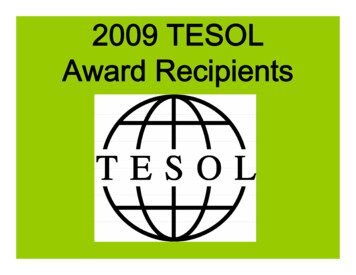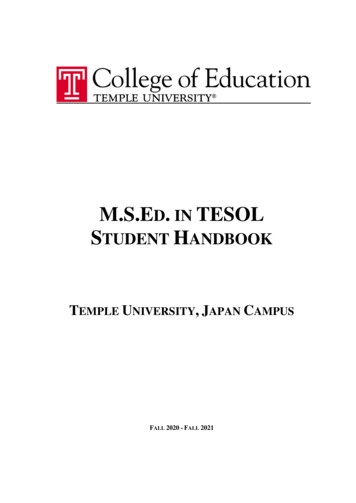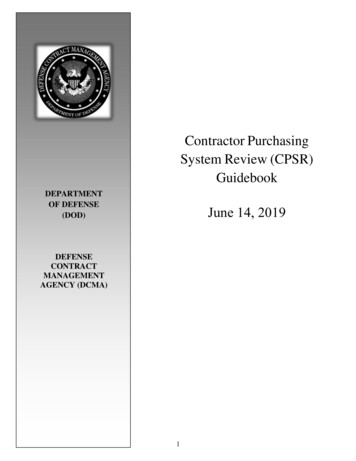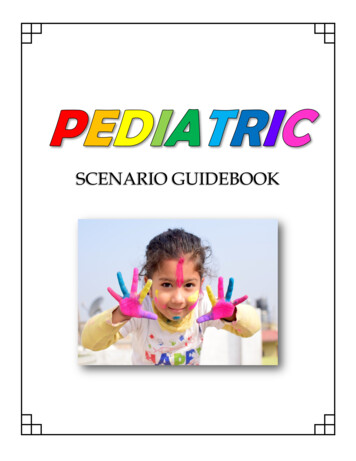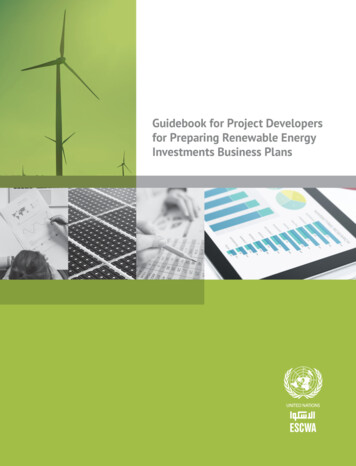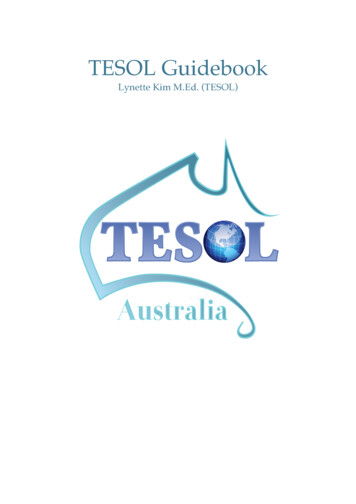
Transcription
TESOL GuidebookLynette Kim M.Ed. (TESOL)
Table of ContentsModule 1: The TESOL Industry and Methodology4Certificate IV 40649SA: Units AABBH & AABBK4Unit 1: The TESOL Industry1.1 Profile of TESOL Employment Sectors1.2 Countries With the Greatest Demand for TESOL Teachers1.3 TESOL Acronyms1.4 Fields of TESOL TeachingUnit 2: Second Language Acquisition2.1 Krashen’s Theory of Second Language Acquisition2.2 The Human Capacity to Learn Language; FLA and SLA Comparison2.3 ESL Language Levels2.4 Placement Testing2.5 ESL Teaching MethodologyUnit 3: Lesson Planning and Delivery3.1 ESL Warm Ups3.2 Lesson Plans3.3 The ESL Lesson Plan Template3.4 Activities or Tasks for Lesson Plans3.5 Flashcards3.6 Worksheets3.7 Games3.8 Finding and Selecting Resources for TESOL Lessons3.9 Advantages and Disadvantages of Using ESL Course Books3.10 Selecting ESL Course Books3.11 How to Guide: Using Course Books3.12 Making Good Use of the Whiteboard3.13 Self-Reflection and Lesson Plan Evaluation3.14 Evaluate Design and Delivery of a Program of Study3.15 Evaluation of Student Progress3.16 Assessing Learner 4848893Module 2: Linguistics96Certificate IV 40649SA: Units AABBL & AABBG96Unit 4: Linguistics4.1 Linguistics Overview4.2 The History of the English Language4.3 Grammar Overview4.4 Key Parts of Speech4.5 Sentences4.6 The Art of ParsingUnit 5: Vocabulary5.1 Overview5.2 Building Vocabulary5.3 Drills5.4 TPR (Total Physical Response)5.5 SlangUnit 6: Effective ESL Teaching6.1 Qualities of a Good Teacher6.2 Transformational Leadership6.3 Humor in the ESL Classroom6.4 Teaching and Learning Styles 2017 TESOL AUSTRALIA 1331342
6.5 The Myers Briggs Type IndicatorUnit 7: Technology in the ESL Classroom7.1 Teaching and Computers7.2 Interactive Whiteboards7.3 DVD and TV7.4 Music and Songs135136136136138141Module 3: Communication142Certificate IV 40649SA: Units AABBM, AABBK, AABBH142Module 4: Teaching Children, Adults and Business English169Unit 8: The Four Language Skills8.1 The Listening Skill8.2 The Speaking Skill8.3 Pronunciation8.4 The Reading Skill8.5 The Writing SkillUnit 9: Children in the ESL Classroom9.1 Developmental Milestones9.2 Social and Emotional Development9.3 Considerations9.4 Classroom Management9.5 Introducing Activities and Tasks9.6 Activities and Games for Teaching ChildrenUnit 10 Adults in the ESL Classroom10.1 The Adult Learner10.2 Considerations10.3 Classroom Management10.4 Independent Learning10.5 Multiple Intelligences in the ESL Classroom10.6 Learner Needs AssessmentUnit 11: Business English11.1 The Business English Student11.2 Profile by Nationality11.3 Guidelines for Cross Cultural Communication11.4 Needs Assessment for Business English11.5 Developing a Business English CourseTeaching Online12.1 Industry Introduction12.2 Employment Opportunities12.3 Teaching Online as a Home Business12.4 YouTube12.5 Getting Paid Via PayPal12.6 Creating Your Own Website12.7 Online Resources12.8 Working for Online ESL Schools12.9 What do Online Schools Expect of Their Teachers?12.10 Tips for Teaching Online12.11 List of Online schools13. References 2017 TESOL AUSTRALIA 102122142152172172192203
Module 1: The TESOL Industry and MethodologyCertificate IV 40649SA: Units AABBH & AABBKUnit 1: The TESOL Industry1.1 Profile of TESOL Employment SectorsThere are two main employment sectors in the TESOL industry: those in nonEnglish speaking countries and those in Native English speaking countries.Each of these offer work in a variety of educational institutions. The followingis a breakdown of these two sectors and the employment opportunities forTESOL teachers.Non-English speaking countriesKindergartensKindergartens, to begin with, employ a large number of TESOL teachers. Thisis due to the trend to expose children as early as possible to English as a secondlanguage, which has increased in popularity over the past decade. Parents ofchildren aged from 0 to 5 are willing to spend large amounts to ensure thattheir children receive the very best education so that they can thrive in a highlycompetitive educational environment later in life.Education has become highly competitive in Asia, starting with kindergartens,and therefore native English speakers are now sought after as assistantteachers. TESOL teachers in kindergartens are not expected to care for the dayto-day needs of children – native teachers do this. Instead, they are needed tosimply interact with the children and teach simple things like the alphabet,numbers and words in a fun game-filled way. Their working hours vary, butare usually 4 – 6 hours per day, 5 days a week.Government and private Primary/Elementary, Middle & High schoolsThe next major employer of TESOL teachers is the government and privateschools. Students vary in age depending on the country, but usually begin atage 6 in grade 1 through to age 17, graduating from high school. Class sizesvary a great deal, but it is not uncommon to find classes of 30 or more. Mostclasses comprise of students of mixed language ability within two languagelevels, i.e. Elementary/Pre-intermediate. Lessons run for an average of 50minutes, with the teacher then moving on to the next class.This means that most students receive approximately two hours per week ofESL instruction with a foreign teacher. When teaching in schools, the lessonsare focused on the skills of listening and speaking, with an emphasis on 2017 TESOL AUSTRALIA V000194
conversation, dialogues, drills and role-playing. Grammar instruction isdiscouraged, as this is the job of bi-lingual teachers. Materials used mostlyconsist of course books, which are usually provided by the school, althoughteachers can usually incorporate their own materials.Language Institutes & collegesAnother high volume employer of TESOL teachers is private languageinstitutions. Class times vary from early mornings to very late at night and mayinclude split shifts. This is due to the fact that most students in languageinstitutes also attend school or work during the day.Most institutes will provide course books and materials for classes but willexpect the TESOL teacher to be able to adapt these to create highlycommunicative and interesting lessons.UniversitiesUniversities also have a demand for native English speakers. Many provideconversational based English instruction and opportunities for their studentsto practice English communication. Classes are usually very large and arewithin normal working hours, ranging in length from 50 minutes to an hourand a half.Online schoolsAn emerging employer of TESOL teachers is online educational institutions.These educators have usually been providing online instruction in othereducational fields, such as mathematics and grammar, and are now branchingout to provide ‘live’ English language lessons over the Internet. More and more,students are demanding fast and convenient study options, and thereforeonline teaching is increasing in popularity. Working hours are set to suit theteacher’s availability and classes can be small or very large – up to 30 or morestudents.Large companies & businessesToday, most large companies throughout Asia, the Middle East, South Americaand Europe deal with business on a global scale.This requires them to be able to communicate effectively using the Englishlanguage. As a result, many companies employ TESOL teachers to provideongoing ESL instruction and training for their non-English speakingemployees. Normal working hours usually apply, although some lessons arescheduled immediately after work hours so as not to interrupt the work. 2017 TESOL AUSTRALIA V000195
English speaking countriesPrivately owned Language School/InstitutesServicing to a stable market of international students wanting to learn Englishin an English speaking country is the primary goal of privately ownedlanguage schools and institutes. Work hours are usually normal school hours,however, some schools provide after hours instructions.Government & Privately owned Primary & High schools with ESL programsA large number of schools provide ESL support classes for international andmigrant students learning English as a second language whilst attending theschool. Work times are within normal school hours.TAFEELICOS centres in TAFE are similar to Language institutes, providing ESLclasses for both international students and migrant programs. Normal workhours apply.UniversitiesMost universities provide ESL programs for international students withpathways such as EAP or Proficiency courses, leading to acceptance in degreeprograms.Migrant programsThere are a number of migrant programs for temporary and permanentresidents run in countries with migration policies. In Australia, for example,migrants are offered 500 hours of the Government funded language tuition. 2017 TESOL AUSTRALIA V000196
1.2 Countries With the Greatest Demand for TESOL TeachersMany countries around the world offer countless jobs for TESOL qualifiedteachers. At any time there are literally hundreds, if not thousands of TESOLjobs on offer around the world. The countries listed below are the largestemployers of TESOL teachers and offer all year round work.China: highest demand, hundreds of jobs in all ESL sectorsHundreds of jobs on offer at any time. Teaching primarily focuses on children,although classes for adults are also very popular. Chinese children expectclasses to be difficult, but are very interested in foreign teachers and are eagerparticipants. Emphasis can often be placed on the quantity of material coveredrather than the quality of learning, although nowadays many Chinese schoolsare trying to implement as much speaking time in class as possible, despite thelarge classroom numbers.Adult Chinese students are highly motivated learners with a very set idea ofhow English should be learnt. Adults may find it difficult to adapt to an easygoing style of ESL and tend to rely heavily on grammar instruction and teachercorrection. It is best to provide lessons with plenty of speaking/pronunciationpractice and correction through the use of drills, dialogues, discussions, as wellas free talking time. Chinese students come from a background of highlystructured education, which can make them reluctant to participate freely atfirst, but once they are warmed up, they readily join in and enjoy the lessons.Korea: high demand for TESOL teachers in all sectorsA high amount of jobs on offer, all year round. Many jobs are in kindergartensand schools, followed by language institutes, universities and businesses.Korean children study long hours and can be lethargic in lessons; therefore,motivation is a big factor. Adults enjoy classes, like constant correction andwant plenty of speaking opportunities in-class.Japan: jobs available, but slowing demandA constant stream of jobs, mostly in language institutes teaching children.Japanese students are usually quiet but motivated learners. Like Koreans, theylike error correction and are comfortable with grammar terminology.Other Asian countries: constant demand 2017 TESOL AUSTRALIA V000197
Laos, Vietnam and Thailand have a constant demand for TESOL teachers, withmost work in schools and language institutes teaching children. Learners aresimilar to the Chinese.Middle East: constant demandMost employment in this region is teaching in language institutes and workingwith young adults. Students are generally motivated and diligent. They expecthigh results from themselves and look to the teacher for structured lessons andstrict adherence to rules and discipline.South America: constant demandMany of the jobs in this area are in language institutes and schools. Studentsare generally outgoing and highly communicative.Europe: constant demandSchools and language institutes are the highest employers. Students aregenerally motivated and enjoy cultural exchanges.TESOL Teacher Activity 1Research online the TESOL employment sectors you are interested inworking in by Googling ESL search terms. List the information you findbelow.1.3 TESOL AcronymsThere are many acronyms used internationally in the TESOL industry with noone specific international accrediting body to regulate. As a result, different 2017 TESOL AUSTRALIA V000198
countries use different acronyms to define certain fields. The following is a listof the most commonly used acronyms with their definitions.Acronyms related to teachers of English as a second language: TESOL: Teacher/Teaching of English to Speakers of Other Languages –teaching English in either a non-English speaking or English speakingcountryTEFL: Teaching English as a Foreign Language – teaching English in anon-English speaking countryTESL: Teaching English as a Second Language – teaching English in anEnglish speaking country to non-English speakersELT: English Language Teaching – teaching English as a second languagein the UKAcronyms related to the English as a second language industry in general ESL: English as a Second Language – the field of English language studiesin second language acquisitionEFL: English as a Foreign Language – the field of English as a secondlanguageAcronyms related to specific areas of English as a second language teaching ESP: English for Specific Purposes – the teaching/studying of English forindividual or group with specific needs EAP: English for Academic Purposes – English programs for highereducational studies, i.e. university entrance 2017 TESOL AUSTRALIA V000199
Acronyms related to English language proficiency: IELTS: International English Language Testing System –Australian/British based English for higher education, immigration &employmentTOEFL: Test of English as a Foreign Language – North American basedtest of English for higher educationTOEIC: Test of English for International Communication – South Koreanbased test of English for higher education & employmentCambridge Suite: PET Preliminary English Test, FCE First Certificate inEnglish, CAE Certificate in Advanced English, BEC Business EnglishCertificate and CPE Certificate of Proficiency in English are all Britishbased tests of English for higher education & employment run byCambridge English UK. 2017 TESOL AUSTRALIA V0001910
1.4 Fields of TESOL TeachingThere are a number of fields in which a TESOL teacher can find teaching workas per the list below. Generally, teachers start out teaching GE General Englishcourses and/or Conversation classes, and then, as they develop teachingexperience and confidence, they may go on to teach other more specializedcourses.GEGeneral or conversational English courses that cover the 4 language skills oflistening, speaking, reading and writing, taught within everyday life basedtopics for children and adults. Most course books are designed to teach GE andare followed in class as they provide a well-structured curriculum from onelanguage level to the next.Business EnglishBusiness topics, contexts, vocabulary and materials that are generally taughtfrom course books.EAPEnglish for Academic Purposes. In general, course books are used that havebeen designed to cover all aspects of preparation for higher academic studies –from essay writing to oral presentations. EAP courses usually run for a 10-12week period.Medical EnglishAn English course designed to orient foreign nurses and doctors wishing towork or undertake medical studies in an English speaking country.Hospitality EnglishThis course is usually taught in conjunction with GE for students who willundertake a hospitality course, i.e. TAFE in an English speaking country. Itspurpose is to orient students with terminology and culture in order to preparethem for their chosen study field. 2017 TESOL AUSTRALIA V0001911
Language proficiency coursesLanguage proficiency courses are designed to teach the requirements ofpassing a specific course, i.e. IELTS and TOEIC. Language proficiency coursesnormally run for a 12-week period, culminating in the student taking the actualtest. The table below is a breakdown of the most commonly studied proficiencytests.Table of language proficiency testsTestIELTSLanguage skillstestedTime limit for eachskill testedListening30 10 min totransfer answersSpeakingNumber of tasks &questions4 passages 40questions14 – 16 min3 partsReading(General &Academic)60 minPassages 40questionsWriting(General &Academic)60 min General&Academic2 tasks40 min4 parts 30questions14 min4 parts60 min3 parts 30questions80 min2 parts45 min4 parts 30questionsSpeaking20 min11 questionsReading75 min100 tening60 min45 min20 min60-80 min50 min60–90 min8 questions100 questions6 tasks36-56 questions2 tasks34-51 questionsListeningScoring systemBand score 0 - 9SpeakingReadingFCEPass or failWritingUse oflanguageTOEICTOEFL 2017 TESOL AUSTRALIA V000190-10000-12012
Unit 2: Second Language Acquisition2.1 Krashen’s Theory of Second Language AcquisitionHow is language learnt and what is the best way to teach and learn a secondlanguage?The factors involved in Second Language Acquisition (SLA) could be likenedto notches strategically cut into a key. Just as a single notch alone cannot unlocka door, a single factor in SLA cannot adequately explain how a second languageis acquired. Attention is eloquently brought to this point in the five hypothesesof Krashen’s theory of SLA. This theory is often referred to as the Inputhypothesis, but it is, in fact, a combination of the Acquisition-Learninghypothesis, the Monitor hypothesis, the Natural Order hypothesis, theAffective Filter hypothesis and the Input hypothesis. Each of these hypothesesexplains a specific aspect or factor involved in the complex processes of SLA.This essay will discuss the main claims in Krashen’s SLA theory and theinsights it gives in SLA pedagogy.The Acquisition-Learning hypothesis is one of the most well known ofKrashen’s hypotheses in linguistic circles. According to this hypothesis, thereare two SLA performance systems: the ‘acquired’ system and the ‘learnedsystem’. The acquired system posits that learners require meaningful, naturalcommunication in the second language. This system does not concentrate onform as a means of acquisition; instead, it is claimed that the acquisition is aproduct of a subconscious process, similar to the processes young childrenundergo in First Language Acquisition (FLA). In contrast, the ‘learned system’is a formal instruction consisting mainly of form and grammar, which resultsin conscious knowledge about the target language and is only of benefit inmeasuring production (Schütz, 2007).The Acquisition-Learning hypothesis, as one of the main claims of Krashen’stheory, touches upon the innate learner-generated nature of languageacquisition through the ‘acquired system’ and the instruction of form andgrammar in the ‘learned system’ as a means of monitoring progress.However, it does not explain the actual processes undergone by the learnersduring the SLA process, such as the creation of inter-language between L1 andL2 to bridge gaps in knowledge. According to this hypothesis, lessons in theSLA classroom would need to be based on either the Task-based approach orthe Communicative approach with activities that reflect the real world. Thiswould also indicate a need to allow learners to ‘pick’ up form naturally, ratherthan teach it directly.The second hypothesis discussed is the Monitor hypothesis. According toKrashen (Schütz, 2007), students implement a form of in-built ‘monitor’ or 2017 TESOL AUSTRALIA V0001913
editing system in SLA to help them bridge the gaps in knowledge of form andrules. It is posited that this inbuilt ‘monitor’ acts as an editor utilized by learnersfor correcting errors as part of the aforementioned ‘Learned system’. Forstudents to be able to utilize this system, three conditions must be met. Firstly,there must be ‘sufficient time’ allowed in the production phase of language forthe learner to consider and implement the correct rules or structure. This is notsuch a problem for the learner when using the writing skill, as long as thelearner knows the required rules. However, implementing monitor in theproduction phase of the speaking skill stilts the natural flow and pace of theconversation, and therefore is less viable in the language classroom as learnersdo not have sufficient time to formulate responses. The second condition to bemet is the ‘focus on form’. Learners need to be focused not only on ‘what’ theywill say, but also consciously focused on ‘how’ they will say it.This focus requires that the students simultaneously think about rules andmeaning, and requires sufficient time and knowledge.The third condition is, ‘knowing the rule’. Learners must already know the ruleto be applied in order to monitor. Learning of rules tends to follow a ‘naturalorder’ from the simplest that do not require elaborate movements, to rules thatare syntactically simple, such as bound morphology (Krashen, 1982).The Monitor hypothesis explains the conditions necessary for SLA learners toself-correct; this self-correction is evidenced by learner hesitations and longpauses in learner speech production. However, as part of its claim, the ‘Monitorhypothesis’ posits that learners would already have learnt form and rules aspart of the ‘Learned system’ in the Acquired hypothesis or have picked-up therules automatically as part of some kind of ‘natural order’ in grammar learning.This hypothesis is heavily reliant on the learner having a reasonable amount ofknowledge of the target language and does not account for zero beginners oryounger SLA learners who are focused on the expression of meaning and donot inhibit themselves with a need for correctness. The Monitor hypothesisraises some very important teaching implications, particularly for the SLAclassroom.It highlights the need for a relaxed and communicative learning environment,along with students who feel encouraged and motivated. These factors wouldneed to be considered in lesson materials and delivery. Teachers of ESL shouldalso pay particular attention as to whether they have excessive Monitor usersin their classrooms, and if so, they should redirect their students’ attention tothe meaning instead of form.The third of Krashen’s hypotheses to be discussed is the ‘Natural Order’hypothesis. This hypothesis is based on the research of the natural order ofgrammar acquisition. Statistically, certain grammatical structures are acquiredearlier than others, although age and language distance need to be taken into 2017 TESOL AUSTRALIA V0001914
account in SLA. An example of this acquisition order is the acquiring of thebound inflectional morpheme ‘ing’ denoting tense, i.e. ‘running’, which isstatistically one of the earliest structures learned, whereas the boundinflectional morpheme ‘s’ to denote possession, i.e. ‘Josh’s cat’, is statisticallylearnt much later (Schütz, 2007). The ‘Natural Order’ hypothesis accounts forlearners acquiring an understanding of structure that may not have beenpreviously taught; therefore, accounting for the innate factors involved in SLA.However, as ‘meaning’ must be taught in useful communicative contexts, usingthe ‘Natural Order’ hypothesis as a guideline for a SLA syllabus would beconsidered ineffective (Krashen, 1982). The Natural Order hypothesis wouldindicate a need for SLA teachers to allow students to discover form andgrammar rules naturally, rather than being taught them as a direct syllabus.This would impact on the types of learning materials used in the languageclassroom and the way in which this material is taught.The Fourth hypothesis to be discussed is the ‘Input’ hypothesis. The Inputhypothesis claims that learners acquire knowledge by understanding meaningin language first, and as a result, knowledge of structure is automatically learnt.This understanding or learning of meaning is accomplished through thelearner being presented with ‘comprehensible input’. Comprehensible input isthe key to SLA in this hypothesis and comprises of input at the level the learnercurrently comprehends, combined with input at the next level ofcomprehension. This level combined input, affords the learner an opportunityto progress according to the ‘natural order’, as outlined in the Natural Orderhypothesis (Schütz, 2007).This particular hypothesis is acquisition based, incorporating factors such ascontext and the learner’s knowledge of the world and innate extra-linguisticinformation.According to the Input hypothesis, fluency emerges at different times fordifferent learners, but not as a result of the systematic teaching of grammaticalstructures, but rather due to the amount of comprehensible input the learner isexposed and comprehends over time. Examples of comprehensible input beingutilized in learning can be found in the usage of ‘caretaker speech’ used byparents with their offspring or ‘teacher talk’ used by teachers in the languageclassroom. This particular type of speech is ‘rough tuned’ to the learners’current level of ability, but not ‘finely tuned’ so as to be too simple. This roughtuning allows the learner to draw upon their own learning ability by utilizingtheir knowledge of the world, the current environment and innate extralinguistic information (Krashen, 1982).This particular hypothesis in Krashen’s theory of SLA gives a logicalexplanation as to how language is acquired positing that the acquisitionprocess is dependant upon the learner’s environment, the input the learner isexposed to and the learners’ own inbuilt extra-linguistic information. It also 2017 TESOL AUSTRALIA V0001915
claims that fluency emerges on its own over time, according to the learner’sindividual capacity. Although the ‘Input’ hypothesis accounts for the innatenature of SLA operating within the learner, as in the learner capacity to extendcurrent knowledge to the next level, it does not detail ‘how’ this process takesplace. Within the SLA classroom, teachers would need to monitor studentprogress to ensure the material being taught is challenging. In addition, ESLteachers would need to use ‘Teacher talk’ with care to ensure that it iscomprehensible without being too easy.The fifth and last hypothesis in Krashen’s theory of SLA is the ‘AffectiveFilter’ hypothesis. It claims that an ‘Affective Filter’ comes from within thelearner. It is a form of ‘mental block’ which hinders acquisition. It is positedthat there are three factors contributing to the strength of a learners ‘AffectiveFilter’: motivation, self-confidence and anxiety. The first factor, motivation,posits that if a learner is highly motivated, he/she will generally seek moreinput than a learner with lower motivation. Secondly, self-confidence; learnerswho have a healthy self-image cope better with SLA. Thirdly, anxiety; learnerswho tend to be anxious impede SLA by causing the ‘Affective Filter’ to beheightened. According to Krashen, these causative factors are attitudinal andassociated with the acquisition and not learning (Krashen, 1982).The ‘Affective Filter’ hypothesis does not touch on the role of ‘learning’ in SLAnor discuss which areas in acquisition are blocked by the filter. Although, itdoes outline how it is possible for some SLA learners to ‘fall short’ of fluencydespite having been exposed to the same amount of comprehensible input asothers, giving valuable insight into the role the learners themselves play in theacquisition process. According to this hypothesis, SLA teachers would need tocontinually encourage and motivate their students to ensure that they are inthe best possible position to ‘acquire’ language.In summary, by combining all five hypotheses that make up the Krashen’stheory of second language acquisition, a clear picture emerges of the processesthe learner utilizes consciously and the processes the learner undergoes at asub-conscious level. The ‘Learned system’ in the Acquisition-Learninghypothesis highlights the way in which learners consciously rely on learningform and grammar as a means of acquisition.This reliance on form and ‘knowing’ the ‘rule’ by the learner is also evident inthe Monitor hypothesis. Learners do not concentrate on meaning, as in whatthey want to say, but on form as in how they should say it. This consciousconcentration by the learner on learning rather than meaning is demonstratedby constant hesitations in speech. 2017 TESOL AUSTRALIA V0001916
The ‘Acquired system’ in the Acquisition-Learning hypothesis by contrast,demonstrates how meaningful, natural communication in the target languageallows the learner to ‘tune into’ a sub-conscious process or language acquisitiondevice (LAD) similar to the one young children utilize in FLA. Comprehensibleinput is the key to this process, and this is outlined in the Input hypothesis,whereby learners are exposed to input which is ‘at’ their current level ofcomprehension and that of the ‘next’ level. This process allows the learner to‘problem solve’ the gap by utilizing their knowledge of the world, the currentenvironment and innate extra-linguistic information. The Krashen’s theorycovers all areas of the SLA processes undergone by the learner, and explainshow it is possible for some learners to ‘fall short’ in acquisition despite beingexposed to the same learning opportunities (comprehensible input) as others.This is explained in the ‘Affective Filter’ hypothesis as the result of learners’motivation, self-confidence and anxiety levels, raising their affective filterwhich causes a form of ‘mental block’ to acquisition.An interesting example case of the Krashen’s theory of SLA can be found in thecase a twenty-nine year old Mexican immigrant named Armando who speaksHebrew fluently. Although Armando had lived in the United States for twelveyears, he spoke better Hebrew than English.Armando had been working in an Israeli restaurant while living in Americaand had
3.1 ESL Warm Ups 56 3.2 Lesson Plans 56 3.3 The ESL Lesson Plan Template 59 3.4 Activities or Tasks for Lesson Plans 61 3.5 Flashcards 62 3.6 Worksheets 65 3.7 Games 66 3.8 Finding and Selecting Resources for TESOL Lessons 69 3.9 Advantages and Disadvantages of Using ESL Course Books 72 3.10 Select
